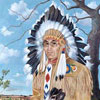 Heritage Community Foundation Presents
Heritage Community Foundation PresentsAlberta Online Encyclopedia
|
Profiles: The Honourable Ralph G. Steinhauer
Ralph Garvin Steinhauer was born at Morley, in southern Alberta (then the Northwest Territories) on 8 June 1905. The son of Josiah Apow and Amelia Mildred Mumford, from the Saddle Lake Cree Nation. Steinhauer’s birth father died in 1908, prompting Steinhauer’s mother to return to Saddle Lake where she later married James Arthur Steinhauer, grandson of the Methodist missionary Henry Bird Steinhauer, who adopted her children and gave them the Steinhauer surname. Steinhauer was educated at the Brandon Indian Residential School and subsequently joined his stepfather on his farm. Eventually, he worked as a clerk at a general store in Vilna, Alberta, ultimately becoming Assistant Postmaster for the town. During this time he met Isabel Florence Margaret Davidson, whom he married on 20 November 1928. Together, the couple raised five children on a farm on the Saddle Lake Reserve. Steinhauer was a staunch advocate of agricultural development at Saddle Lake. A successful farmer himself and a member of the United Farmers of Alberta, he sat on the Saddle Lake Band Council for thirty-seven years, three of those years as band Chief, and throughout his tenure encouraged the Band to become educated in agriculture and farming techniques. The Saddle Lake Centennial Development Association was a successful farming initiative that Steinhauer helped to create. An active member of his community, Steinhauer became involved in federal politics when he ran as the Liberal candidate for Vegreville in 1963. Though he failed to win a seat, he continued to be active in politics all of his life, serving as a founding member and President of such organizations as the Indian Association of Alberta and the Alberta Indian Development Corporation. He was also a member of the federal sub-committee for Indian Economic Development. In 1974, the Liberal Prime Minister of Canada Pierre Elliot Trudeau, appointed Steinhauer to the position of Lieutenant Governor of Alberta. Though Steinhauer was a bit reluctant to leave his farm and take up his new responsibilities, he was keenly aware of the importance of his position as a role model for Aboriginal and non-Aboriginal people alike, and accepted the position. He served as Lieutenant Governor of Alberta until 18 October 1979, after which he returned to his life on the farm at Saddle Lake. For his work and achievements, Steinhauer received numerous honours, including: the Canadian Centennial Medal and the Medal of Service of the Order of Canada in 1967, an appointment as Officer of the Order of Canada in 1972, and an induction into the Alberta Agriculture Hall of Fame in 1984. Ralph G. Steinhauer died in Edmonton on 19 September 1987, and was buried in the United Church Cemetery on the Saddle Lake Reserve, close to the land which had become such a vital part of his life’s work. Sources: Agriculture, Food and Rural Development. “Steinhauer, Ralph G. – 1984 Hall of Fame Inductee” Government of Alberta, 2001-2006. http://www1.agric.gov.ab.ca/$Department/deptdocs.nsf/all/info2062?opendocument (accessed July 2006) “Indian Named Lt.-Governor.” Saskatchewan Indian. May 1974. http://www.sicc.sk.ca/saskindian/a74may17.htm (accessed July 2006). Tribal Chiefs Institute and Indian and Northern Affairs. In Their Footsteps: Contributions of First Nations People in Alberta. Edmonton: Duval House Publishing, 2001. The Heritage Community Foundation. “Lieutenant Governors, The Honourable Ralph G. Steinhauer, 1974-79.” Welcome to Alberta’s Political History. http://www.abheritage.ca/abpolitics/people/lt_steinhauer.html (accessed July 2006). |
 |
|
For more on the making of treaty 6, visit Peel’s Prairie Provinces.



